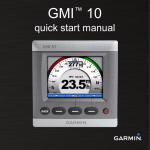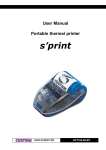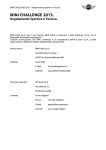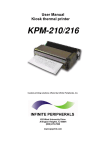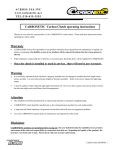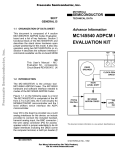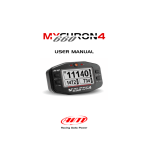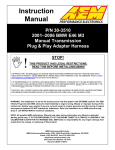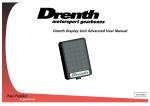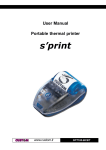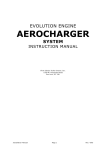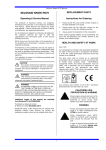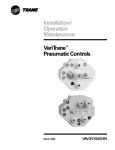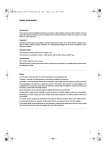Download MP25(M) / MA25(M) Manual V4.14
Transcript
MP25(M) / MA25(M) Manual V4.14 Contents page. 1 KMS (Kronenburg Management Systems) ................................................................ 4 2 Software installation ........................................................................................ 6 3 KMS software .................................................................................................. 8 3.1 The main screen ........................................................................................ 8 3.1.1 The injection characteristic diagram ..............................................................9 3.1.2 The ignition characteristic diagram ...............................................................9 3.2 The function bar ....................................................................................... 10 3.2.1 Function key F1...................................................................................... 10 3.2.2 Function key F2...................................................................................... 10 3.2.3 Function key F3...................................................................................... 10 3.2.4 Function key F4...................................................................................... 10 3.2.4.1 Options ......................................................................................... 11 3.2.4.1.1 RPM pickup ................................................................................ 12 3.2.4.1.2 RPM limiters and Power Shift .......................................................... 16 3.2.4.1.3 Engine load sensor ....................................................................... 18 3.2.4.1.4 Start-up .................................................................................... 22 3.2.4.1.5 Throttle pump effect .................................................................... 22 3.2.4.1.6 Interpol. to limits and Fuel cut ........................................................ 23 3.2.4.1.7 Hardware configuration ................................................................. 24 3.2.4.1.8 Lambda-control .......................................................................... 26 3.2.4.1.9 Boost control .............................................................................. 33 3.2.4.1.10 A.L.S. ..................................................................................... 37 3.2.4.1.11 AUX 1 ..................................................................................... 38 3.2.4.1.12 AUX 2 ..................................................................................... 38 3.2.4.1.13 AUX 3 ..................................................................................... 38 3.2.4.1.14 External Dashboard .................................................................... 39 3.2.4.1.15 Remarks .................................................................................. 40 3.2.4.1.16 Speed settings ........................................................................... 40 3.2.4.1.17 Communication port ................................................................... 40 3.2.4.2 Output test .................................................................................... 42 3.2.4.3 Crankshaft sensor test ....................................................................... 42 3.2.4.4 Motor + system diagnostics ................................................................. 43 3.2.4.4.1 Runtime .................................................................................... 43 3.2.4.4.2 Over-revving of the RPM limiters ...................................................... 43 3.2.4.4.3 Crank sensor .............................................................................. 44 3.2.4.4.4 Oil pressure ............................................................................... 44 3.2.4.4.5 Water temperature sensor ............................................................. 44 3.2.4.4.6 Air temperature sensor ................................................................. 45 3.2.4.4.7 Throttle Position Sensor ................................................................ 45 3.2.4.4.8 MAP sensor ................................................................................ 45 3.2.4.4.9 Battery voltage ........................................................................... 45 3.2.4.4.10 Air pressure sensor ..................................................................... 46 3.2.4.4.11 Overflow injection time ............................................................... 46 3.2.4.4.12 Lambda control ......................................................................... 46 3.2.4.4.13 5V sensor supply ........................................................................ 46 3.2.4.4.14 ECU ........................................................................................ 46 3.2.4.5 Change user access level .................................................................... 47 3.2.5 Function key F5...................................................................................... 48 3.2.6 Function key F6...................................................................................... 50 3.2.6.1 Idle-control options .......................................................................... 50 3.2.7 Function key F7...................................................................................... 51 3.2.8 Function key F8...................................................................................... 51 3.2.9 Function key F9...................................................................................... 51 3.2.10 Function key F10 ................................................................................. 52 3.2.11 Function key F11 ................................................................................. 52 3.2.12 Remaining shortcuts Alt + H ................................................................... 52 KMS MP25(M)/MA25(M) manual Version 4.14 2 3.3 4 5 The communication bar .............................................................................. 53 Programming .................................................................................................. 55 4.1 Manual changing ....................................................................................... 55 4.2 Bar charts ............................................................................................... 55 4.3 3D graph changing ..................................................................................... 57 Hardware installation ...................................................................................... 58 5.1 Fitting the ECU ......................................................................................... 58 5.2 Connecting the communication cable ............................................................ 58 6 Fault tracing .................................................................................................. 59 7 Specifications ................................................................................................. 60 8 Wiring diagram ............................................................................................... 61 Appendix 1: Trigger pattern drawings ........................................................................ 62 Appendix 2: AIM display connection and channels ......................................................... 65 KMS MP25(M)/MA25(M) manual Version 4.14 3 1 KMS (Kronenburg Management Systems) Kronenburg Management Systems (KMS) is a complete line of programmable engine control units (ECU), that offers you an extremely reliable and user-friendly system at a very competitive price. It gives you the possibility to manage all turbo and naturally aspirated Otto engines (engines in which the fuel mix is ignited via a spark plug) up to 12 cylinders. An engine control unit is a type of electronic control unit that determines the amount of fuel, ignition timing and their parameters which is needed to keep an internal combustion engine running. It does this by reading values from multidimensional maps which contain values calculated by sensor devices monitoring the engine. The programmable KMS ECU doesn’t not have a fixed behaviour, but can be (re)programmed by the user. Programmable ECU’s are required when a significant modification has been made to a vehicle's engine. For example adding a turbocharger, changing the camshaft profile or a conversion to an alternative fuel. In these situations, a programmable KMS ECU can be wired in. The KMS ECU’s can be programmed/mapped with a laptop connected using a serial or USB cable, while the engine is running. The programmable ECU controls the amount of fuel to be injected into and ignition moment for each cylinder. This varies depending on the engine's RPM and the position of the gas pedal and/or the Manifold Absolute Pressure (MAP). This can be adjusted by bringing up a spreadsheet page on the laptop where each cell represents an intersection between a specific RPM value and a throttle position. In this cell a value corresponding to the amount of fuel injected can be entered. This spreadsheet is referred to as a fuel table or fuel map. The same way the ignition spreadsheet can be setup. By modifying these values while monitoring the exhaust gas composition (best way is using a wide band lambda sensor) you can see if the engine runs rich or lean. This way you can find the optimal amount of fuel and optimal ignition moment needed for all possible combinations of RPM and throttle position/manifold absolute pressure. This process can be best carried out at a dynamometer, giving a controlled environment (without influence from outside) to work in. An engine or chassis dynamometer gives a more precise calibration for your (racing) applications. The KMS MP25(M)/MA25(M) ECU offers a complete self learning air fuel ratio control (lambda control) for most common types of oxygen sensors (broadband/narrow band). In addition to lambda control, this management system also provides the following functions: loaddependent boost pressure control, water injection control, (variable) launch control, powershifting, (variable) A.L.S., staged/banked injection, mapselector, odd fire, idle control, rpm limiters, engine diagnostics, etc. This management system can be used as an independent injection/ignition system for virtually all types of Otto engine, but can also be used in combination with a standard engine management system. It can take over the standard injection/ignition at any desired engine speed, boost pressure or throttle valve position. Precise ignition and air/fuel mixture control leads to excellent driveability and low fuel consumption. We advice to read the manual complete before starting. The set-up of the system software is kept as clear and simple as possible, so that even people with little computer experience will be able to use this system. Working with the software is simple, but if the settings are incorrectly configured, there is a serious risk of engine damage. In this manual there are warning signs and notes that need your extra attention to bring this setup to a good end. We recommend you leave the programming to specialists. KMS MP25(M)/MA25(M) manual Version 4.14 4 WARNING: Disconnect the battery cables when you’re doing electrical work. Disconnect the KMS ECU from the wiring harness connector when welding on the vehicle. Make sure there are no fluid leaks and all connections are secured and/or tightened. Wiring and fuel system components must be mounted away from heat sources or shielded if necessary. Do not use a batterybooster or a 24V charger. Do not reverse the polarity of the battery or the charging unit. Do not change the battery with the engine running. The peak power supply could severely damage the KMS ECU and other electrical devices. Avoid open sparks and flames near flammable substances. Do not use unsuppressed spark plugs and leads. They can cause electromagnetic interference. KMS MP25(M)/MA25(M) manual Version 4.14 5 2 Software installation The software is supplied together with the system, on a CD-ROM. Installing the software is very easy. The CD-ROM carries the KMS installation program, which launches automatically when the CD is inserted. The program KMS FIRMWARE DOWNLOADER can be used to update the ECU. When there are new options available, they can be downloaded as a zip file from the Van Kronenburg website. The zip file consists of 3 files and a ‘readme’ text file, see figure below. Unpack the zip file on your computer in the KMS Firmware downloader folder. This is the location where you installed the Firmware downloader, see example below. KMS MP25(M)/MA25(M) manual Version 4.14 6 With the firmware downloader this update file can be sent to the ECU (only 1 of the 3 files is visible with the firmware downloader, (see figure below). For MP25(M) and MA25(M) the update file name starts with the number 3 and has extension *.FM1. It’s only possible to use this firmware downloader if you have an KMS ECU with serial nr. higher then 330000. Once installed, the program is set to work via communication port COM1. If this port is already being used or not available, another communication port can be used. For the procedure to change the communication port, see 3.2.4.1.17 Communication port. (USB connections have the most various numbers of communication ports, so make sure you’ve got the communication port right. For settings and finding the right communication port check paragraph 3.2.4.1.17 Communication port) KMS MP25(M)/MA25(M) manual Version 4.14 7 3 KMS software When the program is started, the main screen will appear, which is composed of three parts: The main screen The function bar The communication bar The following sections describe the possibilities and functions of the system. 3.1 The main screen The main screen consists of two spreadsheets (ignition and injection) of which only one is visible at a time. To toggle between the diagrams use function key F11. The spreadsheets are two-dimensional diagrams showing engine speed against engine load. The engine speed range can stretch from 500 rpm to 20.000 rpm. Standard the screen stretches from 500 rpm to 12.500 rpm. This however can be changed (see 3.2.4.1.1 RPM pickup). The RPM range is divided over 25 boxes. The engine load range is sub-divided into 16 boxes dividing the range that has been set for the engine load sensor. The rows and columns are shown in graphs (in the form of bar charts), when the left mouse button is clicked on an engine speed or a load value. For further information, see section 4. Programming. KMS MP25(M)/MA25(M) manual Version 4.14 8 3.1.1 The injection characteristic diagram In the injection characteristic diagram, figures can be entered that indicate the injector opening time per injection in ms. This means that at any engine speed and any engine load, the desired quantity of fuel can be injected. 3.1.2 The ignition characteristic diagram In the ignition spreadsheet, figures can be entered that indicate the ignition advance (in crankshaft degrees before TDC). This means that for any engine speed and any engine load, the desired ignition moment can be entered. KMS MP25(M)/MA25(M) manual Version 4.14 9 3.2 The function bar The vertical bar on the right-hand side of the screen shows several function keys, which can be activated using the mouse arrow or the relevant function keys on the keyboard. An explanation on the different function keys is given in the following sections. 3.2.1 Function key F1 This function key gives access to the manual in Acrobat reader. Acrobat reader 3.0 or higher is required. Acrobat reader 4.0 can be found on the installation CD-ROM. 3.2.2 Function key F2 This function key enables a previously saved file to be retrieved from the hard disk, CD-ROM, USB memory key, etc. The files can be recognized by a floppy MP25(M) and MA25(M) files have the extension *.M03 icon 3.2.3 Function key F3 This function key is used to save modified files. The names of these files automatically receive the extension. MP25(M) and MA25(M) files have the extension *.M03 3.2.4 Function key F4 When this function key is activated, a menu will appear on the screen, which gives the option of several settings and tests. The options will be explained in the following sections. KMS MP25(M)/MA25(M) manual Version 4.14 10 3.2.4.1 Options If 'Options' is selected, a menu appears which lists several possible settings. These settings are described below. KMS MP25(M)/MA25(M) manual Version 4.14 11 3.2.4.1.1 RPM pickup In this menu, the settings for the crankshaft signal, the type of ignition and the injection frequency can be entered. RPM Range: By clicking on the function you can set the rpm range for the main parameter maps (minimum rpm is 500 and maximum is 20.000). Standard the 25 rows are divided over a rpm range 12.500 rpm (example see left figure below). If your engine doesn’t make more than 6.500 rpm, you can devide the 25 rows over this 6.500 rpm (example see right figure below). So the mapping will be more fine tuned for this engine rpm range. KMS MP25(M)/MA25(M) manual Version 4.14 12 Crank pickup: You can enable the crank pickup and set the references. Here you can select if your connected sensor is hall or inductive. Hall sensor: a current runs through a thin Hall-plate. When this plate is undergoing a magnetic field a voltage arises between the two sides of the plate. When a tooth passes the plate the magnetic field changes. Inductive sensor: consists of coil around constantly magnet. The change in magnetic field generates a current in the coil. When a tooth passes the coil with magnetic core the magnetic field changes. When a tooth is approaching the signal gets stronger. When a tooth is passed the signal gets weaker. Difference is the Hall sensor generates a Voltage and the inductive sensor generates a current. TIP: Measure the resistance between two pins by using a multimeter. When sensor is inductive the resistance should be between 0.5 kΩ and 2 kΩ. When the sensor uses a 3 pole connecter there should also be the resistance of 0.5 kΩ – 2 kΩ between two pins. The remaining pin is the shield of the sensor cable. If resistance is not measurable the sensor will be likely a Hall effect sensor. Warning: Do not use unsuppressed spark plugs and leads. They can cause electromagnetic interference. Crank-type: The rpm signal has to be delivered by an hall/inductive sensor using a rotating trigger pattern. The individual pattern types are listed under the pulldown menu. Not all trigger patterns are compatible with all engine types. Possible combinations are listed in this table. Some trigger patterns are shown in Appendix 1: Trigger pattern drawings. When using a 60-2 trigger pattern the maximum engine speed is limited to 12.500 rpm. When using a Hall-sensor, it is nescessary to use a convertor that will change the Hall-signal into an inductive signal (exception below). The convertor has KMS partnumber 01-01-07-0333. Ref. point: The reference point (the position of the piston at the moment the first tooth after the missing tooth/teeth passes the sensor) of the crank pickup sensor can be set between 0 and 180 degrees before TDC (for most engines recommended between 70-120degree). The position of the reference point in the software must be checked. Mark the TDC on the crankshaft pulley or flywheel. Check with a timing light the degrees when igniting on cylinder 1 in TDC with a static engine speed. If the ignition advance set in the software deviates from the measurement with the timing light, than you have to correct the reference point in the software. TIP: set for the complete rpm-range the ignition advance map to 10 degrees. The ignition advance read out on the software screen will be stable and doesn’t change when your engine speed varies a bit. For example your reference point set in the software is 90 degrees. The ignition advance 10 degrees at 1000 rpm. Checking with the timing light on cylinder 1 gives you 5 degrees ignition advance. That’s a deviation of 5 degrees which must be corrected on the reference point. The correct reference point is 90 – 5 = 85 degrees. KMS MP25(M)/MA25(M) manual Version 4.14 13 Warning: When using wasted spark the read out on the timing light must be divided by 2. A timing light displaying 20 degrees advance with wasted spark is in reality 10 degrees ignition advance. Coil on time: A coil should be charged before every discharge (plug spark). The coil charging time is indicated in ms. It should normally be 1.4 to 3.5 ms depending on the type of coil. Longer coil charging leads to unnecessarily high power consumption and heat development, shortening the service life of the coil. Warning: The coils can only be operated via a driver circuit. If the computer is connected to the coil directly, the ECU can get damaged beyond repair. Many modern coils feature a built-in driver stage. However, if a coil without an integrated driver stage is used, the separate KMS ignition driver module with KMS partnumber 01-01-04-0001 will be needed. Dis-coil: The choice is between dis-coil (wasted spark) and single coil control (rotor and distributor cap). If you have a dis-coil (and also when using coil per plug wasted spark) the box has to be ticked. Tacho output: Select the amount of cylinders of the vehicle. You can choose between 4, 5, 6, 8 and 10 cylinders. For a 1, 2 choose 4 cylinders. For a 3 cylinder choose 6 cylinder. Warning: For adaptation to a 5, 8 or 10 cylinder configuration, ensure that the ‘No. of cylinders’ has been specified correctly before connecting the coils. If the coils are connected with the numbers of cylinders incorrectly set, the coils (via output 4 and 5) can get seriously damaged. Firing tooth under 500 rpm: This is for setting the number of teeth before TDC at which an ignition impulse is given (under 500 rpm). Keep this number as low as possible to prevent backfiring when the engine is started. For engines with a high compression ratio it is recommended not to set this to a number higher than 1. KMS MP25(M)/MA25(M) manual Version 4.14 14 Injection in ‘x’ stroke mode: The injection frequency (x) can be set to: 2 times per crankshaft revolution (x = 1) 1 time per crankshaft revolution (x = 2) 1 time per two crankshaft revolutions (x = 4) Normally, it is recommended to select the 4-stroke setting. KMS MP25(M)/MA25(M) manual Version 4.14 15 3.2.4.1.2 RPM limiters and Power Shift 3.2.4.1.2.1 Standard Limiters This menu can be used to set various speed limiters and Power Shift. The standard limiters include a soft and a hard limiter. The soft limiter stops ignition partially so that power is lost. The hard limiter switches off ignition completely. For the KMS MP25(M) and MA25(M) management system the maximum rpm limiter is 20.000 rpm * *: with a 60-2 crank trigger pattern the maximum engine speed is limited to 12.500 rpm. Launch Limit RPM on button At launch limit an extra limiter (start line) can be set which is activated, for instance, by a button that connects pin 19 to the ground. Depending on the type of button, NC (normally closed) or NO (normally open), 'Input NC' will have to be ticked or not. If the NO type is used (recommended) do not tick the box. There is also the possibility to set an extra launch limiter which makes it possible to make the launch limiter variable between these two rpm’s by connecting a potentiometer signal to the analog aux input, which can be configured for this function, see 3.2.4.1.7 Hardware configuration. The potentiometer must have a range between 1 kΩ and 47 kΩ. The 5V and ground for the potentiometer can branched from the 5V/ground sensor supply. The signal (wiper) of the potentiometer must be connected to the analog input. Advanced settings: This can be used to built up boost pressure before start. 'Advanced settings' gives the possibility of setting a fixed ignition moment (between 54 degrees before and 54 degrees after TDC. After TDC is indicated by a negative number), fixed fuel enrichment and fixed PWM boost for several ascending engine speeds. This enables a high boost pressure to be built up in turbocharged engines without further increasing the engine speed. Additional fuel enrichment can be set when launch control is activated, this is needed to cool the engine. During activation lambda-control is switched off. Should the engine speed increase in spite of ‘ignition retard’, the startline limiter will intervene by stopping ignition and injection. The boost pressure can also be limited during launch by setting the duty-cycle (PWM-value) of the boost control-solenoid. Warning: When ignition retard is applied, the temperature of the exhaust gasses may rise so high that the exhaust valves, exhaust manifold and turbocharger will be damaged. We recommend you to activate this function for no longer than a few seconds! KMS MP25(M)/MA25(M) manual Version 4.14 16 3.2.4.1.2.2 Powershift Powershift is a function that can be used for changing gear in sequential gearboxes. A switch on the gearbox shifter enables the engine output to be briefly interrupted, so that a gear change can be made with the throttle valve fully open. This minimizes the duration of gear-change. The duration of the interruption can be set to a maximum of 200 ms. Depending on the type of switch, NO (recommended) or NC, the 'NC' box should be ticked. If the ‘use advance settings’ control box is selected, the ‘advanced settings’ menu must be set. Advanced settings: In this menu you can adjust the shift time for each gear. However, a position sensor must be present on the transmission housing for this purpose. In this menu, you can then specify the ascending output voltages corresponding to the various gears. This can be set manually or automatically. The voltage range is 0 to 5V. Cut time: Here you can set the desired injection cut time for each gear(change) position. The injection will be interrupted for the time set here. Delay time: At the moment the Power-shift switch is activated, it is often desirable to have a short delay before the switch takes effect. This is because some resistance is required to build sufficient power for sequential shifting (charasteristic of sequential gearbox). KMS MP25(M)/MA25(M) manual Version 4.14 17 3.2.4.1.3 Engine load sensor Two engine load sensors called ‘Engine load 1’ (for TPS = throttle position sensor) and ‘Engine load 2’ (for MAP = manifold absolute pressure sensor) can be connected. Even a MAF sensor (mass air flow meter) can be connected (not recommended). Please note that certain combinations will result in the exclusion of some options. The use of two load sensors for most N/A and all turbo-charged engines is higly recommended. Some settings in the software are always related to TPS and some to the MAP-sensor. However there is the possibility to select on which sensor (TPS, MAP, combination TPS/MAP) the main load tables are linked to. In the picture above you can see all the possible combinations. The possible combinations are explained below. Main Load is : TPS All the load tables included lambda target are linked to TPS value. This is normally used for N/A engines with throttle bodies. Main Load is : MAP All the load tables included lambda target are linked to MAP value. This is normally used for turbo/supercharged engines . Main Load is: TPS + MAP as boost correction table Not available for MP25(M) and MA25(M). Main Load is : TPS + MAP as boost correction factor The ignition load table and lambda target are linked to MAP value (the ignition table for a turbocharged and supercharged engine should always be linked to MAP). The injection table however is linked to TPS and works in combination with the boost correction factor to determine the main fuel injection time. KMS MP25(M)/MA25(M) manual Version 4.14 18 TPS + MAP as boost correction factor 350 300 250 Enrichment [%] 200 150 Boost correction factor = 1.00 Boost correction factor = 1.25 Boost correction factor = 1.50 100 50 0 0 100 200 300 -50 -100 -150 Manifold Absolute Pressure [kPa] In the figure above, you can see an example of how different boost correction factors influence the enrichment percentage and injection time. So if the injection time in the complete injection table is set at 10 ms and correction factor set on 1.00 the injection time increases with 10ms/100kPa what results in a injection time of 20 ms at 200 kPa (1 bar boost) and 30 ms at 300 kPa (2 bar boost). With the correction factor set on 1.25 this is 1.25 x 10 ms = 12.5ms/100kPa and thus giving an injection time of 22,5 ms at 200 kPa (1 bar boost) and 35 ms at 300 kPa (2 bar boost). Unregarded the correction factor the negative fuel enrichment (under 100 kPa) will always be at a 1:1 ratio. So if engine runs on 50 kPa (0,5 bar vacuum) the injection value will be 50% of 10 ms = 5 ms. TIP: Try to start the engine with the complete fuel map at the same injection time (4 - 12 ms depending on the injector size) and the boost correction factor set on 1.25. Try to get the engine running smooth with changing the complete fuel map (all cells at once) with positive or negative percentage (using the edit menu). If lambda control is active and the engine is at normal operating temperature you can start programming (the separated cells in) the fuel map with the boost pressure (set) as low as possible. After the injection table is mapped at low boost, the next step is to raise the boost level in steps to the desired boost pressure. Check your fuel correction again. Now don’t correct the injection table with this percentage but correct your boost correction factor with this percentage. Main Load is : TPS + MAP as pressure compensation for N/A engines All the load tables included lambda target and correction tables are linked to TPS value. The injection tables are compensated for the manifold absolute pressure. Engines with standard manifolds often have bypasses and/or solenoids for situations when extra air is needed. This extra air isn’t compensated with fuel when only linking to TPS. The injection table (TPS v RPM) gets corrected with 1% per 1 kPa of MAP pressure offset from 100 kPa. So if the injection time in the complete injection table is set at 10 ms, the injection time decreases with 1ms/10kPa. What results in a injection time of 7.5 ms at 75 kPa. If the engine runs on 50 kPa (0.5 bar vacuum) the injection value will be 50% of 10 ms = 5 ms. This is used for N/A engines. KMS MP25(M)/MA25(M) manual Version 4.14 19 Engine load sensor calibration: The engine load sensor connected to the system will have to be calibrated. The range within which the sensor operates can be set here. A load sensor issues a voltage of 0 to 5V. The range is divided into 8 bits (256 steps). In practice a load sensor does not run through its full range. For this reason, the upper and lower limits must be set, so that the 16 columns in the spreadsheets can be best utilized. There are two ways of calibrating the load sensor: Automatic calibration Manual calibration Automatic calibration. When a throttle valve potentiometer is used, it is easy to opt for automatic calibration. Select 'Automatic cal.' and then keep the throttle valve in rest position, pressing OK. Then turn the throttle valve to full load and press OK again. The minimum and maximum values of the throttle positions will now be shown. A warning will appear if automatic calibration cannot be finished correctly. For possible causes, see 'Fault tracing'. Manual calibration. When a map sensor or an air mass sensor is used, automatic calibration is not easy, because the minimum and maximum output signals of the sensor are not known before the engine has run. We recommend filling in the figures by hand, making sure that the output signal of the sensor under any engine operating condition is between the two figures set. Tip: first set the minimum value 15 and the maximum value 250. If you use a KMS 400 kpa Map sensor there are recommended settings for the calibration on the datasheet of the sensor. Not all load sensors emit signals that are linear with the engine load. For this reason the system offers the possibility to choose between three load characteristics. This enables the upper/lower areas to be made more sensitive or less sensitive. The three load characteristics are linear, logarithmic and e-log and are explained in a overview on below. KMS MP25(M)/MA25(M) manual Version 4.14 20 Image Definition Linear Function The load steps are divided in proportion to the signal. Application MAP-sensor Logarithmic At lower loads the load signal is divided over a smaller number of steps and at higher loads it is divided over a larger number of steps. The action is opposite to that of the logarithmic parabola. Air mass sensor e-log KMS MP25(M)/MA25(M) manual Version 4.14 Single Throttle body setup 21 3.2.4.1.4 Start-up When the engine is started, a certain quantity of extra fuel (in most cases dependent on the coolant temperature) will have to be injected to ensure proper firing of the engine. There is a possibility of giving a start-up injection impulse and start-up enrichment. The start-up injection impulse is given once, at the moment the first crankshaft signal is registered. After the start-up injection impulse, the injection periods shown in the injection graph will be adhered to. As long as the engine speed is lower than 500 rpm, the quantity of injected fuel shown in the first row applies. Proper firing of the engine often requires more fuel (depending on coolant temperature) than the quantity needed when the engine is already running at the same engine speed. This extra enrichment can be entered in the table for the duration of a certain amount of crankshaft rotations. There are four coolant temperature ranges for which an enrichment table can be completed. The additional enrichment (%) in the table can be set during the input of the rpm range. An enrichment map and a startup-pulse can be filled in for four coolant temperature ranges. Above the highest temperature the normal startup pulse will be used. 3.2.4.1.5 Throttle pump effect When the throttle valve is opened, the engine will draw in more air and therefore need more fuel to keep the mix ratio at a constant level. As air is a gaseous substance, it will reach the inlet valve earlier than the liquid fuel, which because of its higher inertia needs more time to accelerate. As a result, there will briefly be a weak mix, causing the engine to 'hesitate'. The faster the throttle valve is opened, the greater this effect will be. To neutralise the effect of fuel having a higher inertia than air, acceleration enrichment can be applied. This means that, depending on the throttle valve opening speed, extra fuel is injected. This prevents the formation of a poor mixture. There are two types of acceleration enrichment (these can be set on/off separately). We recommend to use ‘Type 2’ acceleration enrichment. Type 1: The quantity of extra fuel to be injected can be set for the three engine speed ranges indicated. The duration of enrichment can be set by entering the number of crankshaft rotations. The acceleration enrichment will automatically decrease at lower throttle valve opening speeds. Acceleration enrichment type 1 is always linked to ‘Engine load 1’. KMS MP25(M)/MA25(M) manual Version 4.14 22 Type 2: Mixture [λ] With most engines it is recommended to use only this acceleration type2. However type 2 can be combined with type 1 (for some engines useful). Acceleration enrichment type 2 is always linked to main engine load. The initial burst is one pulse that is directly injected when needed no matter what crank position and will intervene to avoid a short lean mixture. The sensitivity is linked to opening speed of the throttle. A low value for sensitivity means that the initial burst won’t occur fast, a high throttle opening speed is needed. For a high sensitivity value a lower throttle opening speed is needed for initial burst enrichment to occur. The amplifier is more or less a factor for the amount of fuel injected. A higher amplifier results in more enrichment. Additional enrichment follows after the initial burst. After the initial burst, the mixture briefly can get lean again. More enrichment is Throttle pump effect needed. You can choose how many 1,25 rotations the additional enrichment is needed. The amount of extra fuel will 1,2 slowly decrease during these rotations. Sensitivity and the amplifier function 1,15 the same as they do with the initial 1,1 burst. The additional enrichment can be increased by a percentage for the 1,05 water temperature. More enrichment is needed with a low water temperature. 1 The figure on the right gives an indication of how these two types of enrichments affect the mixture, when suddenly the throttle valve is opened. 0,95 No enrichment Initial burst 0,9 Initial burst + Additional enrichment 0,85 0,8 3.2.4.1.6 Interpol. to limits and Fuel cut This function can disable the interpolation between values of the fuel map when the outer limits of the map are 0.0. This enables a safe engine speed limiter to be set or to stop injection entirely when the accelerator is released. In the case of the speed limiter, the engine can be prevented from running on an increasingly poor fuel air mix, which might cause engine damage. This does not apply when the speed limiters are set to a lower maximum engine speed. We recommend to use the standard limiters (see also section: 3.2.4.1.2.1 Standard Limiters) KMS MP25(M)/MA25(M) manual Version 4.14 23 3.2.4.1.7 Hardware configuration Map sensor: If there is a MAP sensor connected to the ECU. Please select this option to enable the MAP input. If set to off this input (pin 16) can be used as a sensor ground for TPS, watertemperature, airtemperature, oil pressure, etc. Oil pressure input: Here you can select if there is an oil pressure sensor connected. You can use a VDO oil pressure sensor (with a range of 0 - 10 bar) or a KMS 1000 kPa pressure sensor. Signal on pin 2 of the ECU connector. If set to off this input (pin 2) can be used as a sensor ground for TPS, watertemperature, airtemperature, MAP sensor, etc. Analog Aux input: You can add an extra analog signal to use for various settings. For this specific input there can be a second Oxygen sensor fitted. Also there’s the option to fit a potentiometer for variable launch RPM/A.L.S. as well as gearbox position sensor or KMS EGT signal. Gearbox position: If gearbox has 0 – 5V position sensor, the signal can be connected to the analog input in order to make variable settings in the powershift and boost control. Variable launch or A.L.S.: 0 - 5V potentiometer can be connected in order to make variable control with Launch or A.L.S.. If set to off this input (pin 4) can be used as a sensor ground for TPS, watertemperature, airtemperature, MAP sensor, oil pressure, etc. Analog Aux input voltage: Select the input voltage range of the analogue input. 2 pre-calibrated settings are also available, second oxygen sensor and KMS EGT signal. Boost control output: Select boost control output, on/off. You can use the boost control and connect a solenoid valve. Setting up the parameters for the boost control is done in the ‘boost control’ screen. See section 3.2.4.1.9 Boost control. If set to off this input (pin 6) can be used as a sensor ground for TPS, watertemperature, airtemperature, MAP sensor, oil pressure, etc. Air-Pressure compensation: Please select if there is a barometric compensation sensor connected. There are two possible options for the sensor. The MP25M and MA25M ECU’s have a sensor on the circuit board. Please tick the box internal. If an external KMS MAP 75 – 120 kPa sensor is connected select external. It’s only possible to use a KMS 75 – 120 kPa sensor. For both cases don’t forget to activate MAP sensor on top of the screen. The air-pressure compensation can only be used in combination with main load set to TPS (see section 3.2.4.1.3 Engine load sensor). With the air-pressure compensation active the ECU uses the correction table (in the main screen click or push ‘F5’). See also section 3.2.5 Function key F5. KMS MP25(M)/MA25(M) manual Version 4.14 24 Diagnostic output: This is an option to check whether the lambda control is still active. When you attach the ground of a diagnostic light to one of these aux’s, the light will go on when the lambda control is deactivated due to error. Idle control output: Select the required output for the idle control. Transferring the idle control output to the boost control is also an option when your not using the boost control(pin6). Then an extra AUX output is available for other options. ALS output: Select the required output for ALS. The maximum current through this output is 1A. See also section 3.2.4.1.10 A.L.S.. Oil pressure sensor: You can use a VDO or a KMS oil pressure sensor (1000 kPa). The VDO sensor must have a range from 0 - 1000 kPa. You can calibrate the oil pressure sensor. This can be done to adjust to the right value to compensate the tolerance in the sensor. The KMS oil pressure can be displayed in absolute pressure. So when the engine is not running the oil pressure read out will still be at 100 kPa. Or you can choose KMS relative, which displays the oil pressure relatively. When the engine is not running the oil pressure read out will be at 0 kPa. KMS MP25(M)/MA25(M) manual Version 4.14 25 3.2.4.1.8 Lambda-control A standard (narrow band) BOSCH lambda sensor or one of the KMS UEGO controllers (recommended) can be connected to the system. Select the relevant lambda sensor in the menu (top left). When the engine is running, the A/F ratio/lambda ratio will show in the communication bar. It is also possible to connect a second lambda sensor/UEGO controller to the system. This 2nd sensor/controller has to be the same as the first one. 3.2.4.1.8.1 Adjustment of air fuel ratio feedback control Lambda controller type: Via this menu you can specify the lambda sensor/controller in use. For wideband sensors, the input signal is via the included controller, while standard narrow band BOSCH lambda sensors can be connected directly to the ECU. Warning: When you have a KMS UEGO Display controller you can choose 3 different types of output signal (type a,b and c). Always check if the output type is the same as selected in this software. Type ‘a’ of the KMS UEGO Display controller has the same output curve as the KMS UEGO controller. Use Lambda sensor: There are different options in this submenu : Use lambda sensor: 1 2 with correction on injection group 1 with correction on injection group 1 You can select on which attached oxygen sensor the correction has to work. Lambda scaling: In this menu the values of the different types of sensors/controllers is visible (not adjustable). The KMS UEGO (display) controllers are pre-calibrated. KMS MP25(M)/MA25(M) manual Version 4.14 26 A/F to Lambda (or vice versa): All the ECU’s are standard set to A/F ratio. You can change all the settings of your ECU to Lambda values. All values will be converted. It is always possible to switch back to A/F ratio. When you switch between A/F and Lambda, these settings have to be saved in the ECU. The KMS software will do this automatically. When ‘yes’ is selected in the pop-up screen, the software will start downloading to the ECU. It will automatically lock the settings after downloading. Idle A/F mix: For inputting the desired A/F ratio for idle rpm. The range is limited by ‘idle mix Throttle pos’ and ‘idle mix RPM’ which will be explained later. Idle Sample delay: During idle rpm, the sampling rate needs to be much lower (for smooth engine operation). This parameter sets the time span between two measurements. Recommended value: 0.5 - 1.0 sec. Idle mix Throttle pos: When the throttle angle decreases under the threshold set here, this is considered as idle. In other words, the sampling or measurement frequency becomes dependent on the value set under ‘Idle Sample delay’ while the A/F ratio adopts the desired value of the ‘Idle A/F mix’. Recommended value: 0.5 - 2.0 TPS-value Idle mix RPM: When the engine speed decreases under the threshold set here, this is considered as idle. In other words, the sampling or measurement frequency becomes dependent on the value set under ‘Idle Sample delay’ while the A/F ratio adopts the desired value of the ‘Idle A/F mix’. Recommended value: ±500 rpm higher than idle rpm. Idle on delay: This value specifies the delay before the ECU reactivates the A/F ratio feedback control after an engine has returned to idle. In this way idle rpm can stabilize first before the A/F feedback control takes effect. Recommended value: 0.5 - 1.5 sec. Throttle Red. To Lock: During rapid reduction of the throttle position (without entering throttle overrun state) the air fuel ratio feedback control has to be deactivated in most engines. At a certain deceleration speed the lambda-signal is disturbed due to less efficient combustion. Here you can specify the decreasing rate that triggers the de-activation of the lambda control. The value input here represents the decrease in engine load between 30 ms. Recommended value: 0.3 - 1.0 KMS MP25(M)/MA25(M) manual Version 4.14 27 Red. Lock time: If the A/F ratio feedback control has switched off during rapid deceleration, the control loop will close again (if the throttle position stabilizes or increases again) after a time specified here. Recommended: 0.5 - 1.0 sec. Throttle Inc. To Lock: During rapid increase of throttle position the air fuel ratio feedback control has to be deactivated in most engines. Here you can specify the increasing rate that triggers the de-activation of the lambda control. The value input here represents the increase in engine load between 30 ms. Recommended value: 0.3 - 1.0 Inc. Lock time: If the A/F ratio feedback control has switched off during rapid acceleration, the control loop will close after a time specified here. Recommended: 0.3 - 1.0 sec. Overrun Throttle pos: Below certain throttle positions, combustion changes to such an extent that the exhaust gas contains a relatively high amount of oxygen. A lean mixture is registered by the lambda sensor, although that is not necessarily the case. Under these conditions it is therefore preferable to deactivate the air fuel ratio control loop. When the throttle position is less than this value (TPS) input here, the air fuel ratio feedback control will be deactivatedd. Make sure this value is always set higher than the Fuel Cut Off value. For example a value between 0.5 - 1.5 (depending on your FCO-value). Overrun RPM turn on: In case of overrun (TPS < overrun throttle position) with the engine speed below a certain threshold, it is desirable to activate the air fuel ratio feedback control again. This will usually have to be set to an rpm of 200 to 1000 above idle rpm. Overrun Lock time: When an engine recovers from throttle overrun, it is usually necessary to wait a while before reactivating the A/F ratio feedback control in order to allow the engine to stabilize. This delay can be input here. Recommended 0.3 - 1.0 sec. Minimum watertemp control on: The coolant temperature above which the A/F ratio feedback control activates. If a KMS UEGO lambda controller is used, the lambda control can already be activated at cold water temperatures. If your using a standard BOSCH lambda sensor (narrow band) is used, it is recommended to activate the lambda control only above a water temperature of 60°Celsius. KMS MP25(M)/MA25(M) manual Version 4.14 28 Delay from start to on: Oxygen sensors require a certain warm-up time after engine start. During this warm-up period, the A/F ratio feedback control cannot function. The warm-up period in seconds can be set here. KMS UEGO recommended time: 10 - 15 sec. Standard BOSCH recommended time: 20 - 30 sec. Max % inc. in Fuel: Specifies the maximum positive (increase) injection compensation. Max % dec. In Fuel: Specifies the maximum negative (decrease) injection compensation Max inc. in 1 sample: Specifies the maximum positive injection compensation between two samples as a percentage. If 0.0 is set in here this function is not active. For example: if the sample rate is set on 10 samples per second. The maximum increase in 1 sample is set on 0.5. Then the lambda control can only compensate 10 x 0.5 = 5% fuel increase per second. Max dec. in 1 sample: Specifies the maximum negative injection compensation between two samples as a percentage. If 0.0 is set in here this function is not active. For example: if the sample rate is set on 10 samples per second. The maximum decrease in 1 sample is set on 0.5%. Then the lambda control can only compensate 10 x 0.5 = 5% fuel decrease per second. Up to main load <: Above this main load value, there is no limit on the compensation between two samples. If 0.0 is set in here this function is not active. Recommended is to set this value after the engine is properly mapped, and to a value of 4.0 - 6.0. 3.2.4.1.8.2 Fault settings Increase A/F target to: When engine load and a certain air temperature exceed both the values set under ‘Air-temp’ and ‘Engine-load’, the whole ‘lambda target map’ can be increased or decreased by the value set under ‘increase A/F target with’. Recommended: -0.2 - -1.0. When engine load and a certain exhaust gas temperature exceed both the values set under ‘EGT’ and ‘Engine-load’, the whole ‘lambda target map’ can be increased by the value set under ‘increase A/F target with’. Recommended: -0.5 - -1.5. KMS MP25(M)/MA25(M) manual Version 4.14 29 Set Max Dec. in Fuel: Here you can input a maximum negative injection correction when the coolant temperature exceeds a certain setting. This parameter can be used as protection against engine overheating. If supplementary enrichment has been set in the coolant temperature compensation table for high water temperatures in order to protect the engine, this parameters of this function can help prevent the A/F ratio feedback control from curtailing supplementary enrichment. Min. Fluctuation at warm-up: Before the A/F ratio feedback control will activate, the oxygen sensor signal first has to fluctuate with the amplitude set here. This is a way to recognize if the lambda sensor is connected and working. Recommended: 0.2 - 0.5. Max. time at max. increase: Here you can input the maximum permissible time for the A/F ratio feedback control to be set to maximum positive correction. After this time span the lambda-control will shut down. If set to 0.0 this function will not be active. Recommendeed time: 3 - 10 sec. Max. time at max. decrease: Here you can input the maximum permissible time for the A/F ratio feedback control to be set to maximum negative correction. After this time span the lambda-control will shut down. If set to 0.0 this function will not be active. Recommendeed time: 3 - 10 sec. If Error on A/F-sensor inc. Fuel by: Here you can input a compensation value (as a percentage) in case of lambda shut down due to error. This can be used as a protection for the engine against running a too lean mixture. Recommended value: 3 - 10% 3.2.4.1.8.3 Target map The A/F target map constitutes the same map structure used in the parameter maps for fuel/ignition. The values input here constitute the target A/F ratio. The A/F ratio feedback or lambda control will strive in each map position to control the A/F ratio towards this target value. This means that you can drive with minimized consumption in the partial load range and fulfill the requirements of emission laws. Towards a full load a richer A/F mixture can be automatically delivered, for the benefit of power and cooling capacity of the engine. The adaptation of values in the target map works in the same way as with the main maps (ignition/injection). When you input 0 in a frame, the A/F ratio feedback control will not be active in the relevant range. In the figure on the left side on the next page is a recommended target map shown for a N/A engine. Next to that (on the right) is a recommended target map shown for a turbocharged engne. KMS MP25(M)/MA25(M) manual Version 4.14 30 Lambda target map for a N/A engine Lambda target map for turbocharged engine 3.2.4.1.8.4 Correction map The A/F ratio feedback control corrects injection times so that the target values (specified in the target value map) are attained. The percentage that the A/F ratio feedback control must correct in order to realize the target values is recorded in a correction map. The values recorded in the correction map can be selected and send as a correction percentage to the injection map. Thus the map can be adapted to minimize percentage of the A/F ratio feedback control, which ensures optimum driving characteristics. Make sure that the engine runs smooth after the correction percentages are send to the injection map. After the percentages have been send to the injection map the entire correction map needs to be reset to zero. Select the control box ‘clear lambda correction map’ and press ‘OK’ twice. Allowed band for A/F ratio: Correction percentages are only recorded in the correction map if the A/F ratio value (lambda value) comes within a specific range of the desired value. This range can be adjusted in two settings. By choosing level 2, the correction value will be recorded in the correction map if the A/F ratio feedback value comes within 0.2 of the target (with level 1 ≤ 0.1). With level 2, a 95% accurate correction map is therefore created while a more precise one is created with level 1. Recommended: Map the engine first on level 2. This way you can create the correction map faster. Allowed band for correction map: The 2 levels that can be selected here relate, in this case, to the deviation between actual and nominal rpm and TPS (value set in map). Correction values are only recorded in the correction map when the rpm and TPS comes within a specific range of the nominal value. With level 2, a 95% accurate correction map is therefore created while a more precise one is created with level 1. Recommended: Map the engine first on level 2. This way you can create the correction map faster. KMS MP25(M)/MA25(M) manual Version 4.14 31 3.2.4.1.8.5 Sample rate Main sample rate: Specifies the number of corrections per seconds of the A/F ratio control. Recommended corrections per second: 6 - 10. Correction amplifier: For input of the control amplifier gain. For a rapid correction to the desired target, the first step of correction must be larger. The gain factor can be entered here. Recommended: 1 or 2. Advanced settings: If the ‘use advance settings’ control box is selected, the ‘advanced settings’ menu must be set. You can set here different sample rates for various RPM/Engine-load ranges. In general with higher engine speeds and engine loads the sample rate can be set higher due to more combustions per second and higher exhaust gasflow. If the sample rate is set too low, the lambda control does not reach the desired target in time. On the other hand when the sample rate is set too high the lambda control will get instable. 3.2.4.1.8.6 Warm-up A/F limits At lower engine temperatures you can set an upper limit on air/fuel ratio. Lambda-control will, under these temperatures, not control the mixture leaner (higher A/F) than the values set in this table. This can be used when KMS UEGO control is set active at cold engine/water temperatures to prevent the engine from stalling, by limiting the A/F ratio, when lambda control will try to reach a too lean target. Most petrol engines will not run on an A/F ratio of 14.7 (λ=1) below 60°Celsius. KMS MP25(M)/MA25(M) manual Version 4.14 32 3.2.4.1.9 Boost control In this menu, the parameters for boost control can be set. Boost value calibration: First of all, the boost pressure readout has to be calibrated so that the boost pressure indicated in the communication bar corresponds to the actual pressure. Boost at MAP output 3.75 V: For inputting the boost pressure (kpa) at a MAP sensor (manifold pressure sensor) output voltage of 3.75 V Boost at MAP output 1.25 V: For inputting the boost pressure (kpa) at a MAP sensor (manifold pressure sensor) output voltage of 1.25 V Solenoid off is: If there is no current to the solenoid valve, the boost pressure will adopt either minimum or maximum pressure depending on the connection of the solenoid valve. Here you need to select the correct control boxes. Boost control (on/off): Here you can decide to switch the boost control on or off. If the boost control is activated in the hardware configuration, the boost pressure will be regulated by the PWM percentages in the PWM table. Boost PID control: Here you can select to activate the control to not only use the fixed PWM values from the PWM chart but PID control calculates an ‘error’ value between the measured and the target boost. The controller attempts to minimize the ‘error’ by adjusting the solenoid position untill the desired boost is reached. This control will only reach the set target pressure if the throttle position value is 15. If the throttle position value is not 15, this control will not be active. However, if the boost pressure exceeds the target pressure in spite of the specified PWM values, the control will intervene to prevent the boost pressure from increasing further. KMS MP25(M)/MA25(M) manual Version 4.14 33 3.2.4.1.9.1 Parameters Boost Control Solenoid frequency: Each control valve has a specific frequency at which it operates best. This frequency can be entered here between 16 and 40 Hz. Sample rate: Specifies the number of measurements per second for detecting boost pressure. In case of control instability, you need to input a lower value. If the control system responds too slowly, a higher value has to be entered. Max PWM: A linear solenoid valve will only open at a certain pulse width and reach a maximum opening at a pulse width less than 100%. Here you need to enter the pulse width (as a percentage) above which the solenoid valve will open completely. Min PWM: Here you need to enter the pulse width (as a percentage) beneath which the solenoid valve will close completely. Start RPM: Here you can enter the rpm at which the control may activate. This helps avoid unnecessary operation of the solenoid valve at low revs. Boost Limit (ignition cut off): In case the boost pressure exceeds the target value (risk of engine damage), you can specify a limit with this parameter. When the boost pressure reaches this limit, ignition and injection will be interrupted. Setup pressure: To allow the turbo system to respond as quickly as possible but not overshooting the target, it is important that the PID control only activates above a certain boost pressure (the boost pressure should reach first a stable pressure with the fixed PWM value). Therefore the setup pressure (in kPa) should be kept slightly lower than the target boost pressure (recommended: 20 – 40 kPa below target pressure). From this setup pressure the PID starts to control the boost up to the target. So it is important that boost pressure will reach setup pressure with the fixed PWM values, otherwise PID control wil not activate! Setup hysteresis: Once the setup target pressure has been reached and the pressure consequently decreases, it is advisable not to switch off the control at once, but to allow for a certain pressure reduction prior to switching off. KMS MP25(M)/MA25(M) manual Version 4.14 34 Correction amplifier: For input of the control amplifier gain. With a gain factor the first step will be larger to reach the target boost value faster. Overshoot reduction: Under certain conditions the boost pressure can exceed the set target pressure faster than normal. With this parameter you can enter the maximum boost pressure increase (in kPa) between 2 samples, before the turbo control intervenes to reduce turbocharging pressure. Overshoot value: If the boost pressure increase exceeds the range specified by overshoot reduction, the turbo control will require a certain gain factor to ensure a rapid reduction of the boost pressure to its target value. The gain factor can be entered here. 3.2.4.1.9.2 Boost target map Via this menu you can enter target boost pressures for separate engine speeds. This target will be used only when PID control is set active and TPS value is higher then 15. 3.2.4.1.9.3 Boost PWM map In this field you can specify for each throttle opening and rpm a fixed duty cycle percentage (PWM %) for operating the control solenoid valve. In other words, you can ensure that boost pressure becomes dependent on throttle opening. If the boost control is activated in the hardware configuration, the boost pressure will be regulated by the PWM percentages in this table. The values in this boost PWM map can be easily copied to the overboost PWM map by selecting the cells and choose ‘copy boost to overboost map’. So the values in the overboost PWM map can easily be increased/decreased by a percentage over the boost PWM map values. KMS MP25(M)/MA25(M) manual Version 4.14 35 3.2.4.1.9.4 Boost options Clicking the ‘Boost options’ tab gives you a pop-up screen where the overboost and boost-reduction settings can be setup. 3.2.4.1.9.4.1 Overboost settings This system allows overboost for a limited time span. This rise above the normal boost pressure can be activated by various variables (refer to ‘activation input’). Activation input: In the pulldown menu you can select which variable will trigger overboost. Behind the variable the value can be set from which the overboost is allowed. Overboost value: When overboost is triggered, the boost pressure will rise above the target value by the percentage entered here. Only when PID control is activated. Overboost PWM map: If overboost is active, the system will use the overboost PWM map. The values in the boost PWM map can be easily copied to the overboost PWM map by selecting the cells and choose ‘copy boost to overboost map’. So the values in the overboost PWM map can easily be increased by a percentage over the boost PWM map values. 3.2.4.1.9.4.2 Enable window for activation Here you can set the margins within overboost is permitted. This to prevent engine damage. Overboost activation time: Specifies the time span during which overboost functions are active after being triggered. Overboost pause time: To prevent the overboost from being activated too rapidly (after a preceding overboost), you can set a pause interval here before overboost can be triggered again. KMS MP25(M)/MA25(M) manual Version 4.14 36 3.2.4.1.9.4.3 Boost reduction to gear position The system has the feature to reduce boost pressure at each separate gear (only possible if the gearbox is calibrated in the system). The values which can be set here are correction percentages on the actual used PWM-map. 3.2.4.1.10 A.L.S. A.L.S. (Anti Lag System): This feature can be used in order to maintain boost pressure (only with turbocharged engines) during ‘closed throttle’ situations to eliminate turbo lag. With the help of an electronic air-valve which can make a bypass around the throttle body, the turbocharger can keep on pumping air into the engine. To prevent the engine from over-revving the ignition can be retarded here at the different rpm levels. For cooling of the engine extra fuel can be added. To limit the boost pressure also a fixed PWM value can be set. The fuel enrichment and PWM boost are both percentages. If using variable A.L.S. by connecting a potentiometer signal you can vary the PWM value from 0 to the value set here in the A.L.S. settings. The potentiometer must be in the range of 1 kΩ - 47 kΩ. The variable signal from the potentiometer must be connected analog aux input on pin 4. The 5V for the potentiometer can be branched from the 5V sensor supply on pin 14. The remaining pin of the potentiometer must be connected to the ground on pin 17. Warning: When using the A.L.S. be aware of extreme wear and shortage of lifespan of the turbo, exhaust-valves, exhaust manifold etc. KMS MP25(M)/MA25(M) manual Version 4.14 37 3.2.4.1.11 AUX 1 The system features three extra outputs. These extra outputs can be separately activated via direct ground (up to 1A) or via relay. They can be used for shift indicators, water injection, cooling fan, Vtec, etc. There is a choice of several combinations of input quantity to activate the AUX output. The AUX output is activated when both the values set are exceeded. If 'none' is selected, this channel will be ignored. A hysteresis can be set for each AUX output. This means that the switching ON value can be set higher than the switching OFF value. The advantage of this is that the output does not need to be switched on and off unnecessarily. An example is a cooling fan that activates at 90 degrees and deactivates at 85 degrees. You can name these AUX outputs freely with a maximum of 2 x 8 characters. 3.2.4.1.12 AUX 2 See section 3.2.4.1.11 AUX 1 3.2.4.1.13 AUX 3 See section 3.2.4.1.11 AUX 1 KMS MP25(M)/MA25(M) manual Version 4.14 38 3.2.4.1.14 External Dashboard The KMS Management system can sent all sensor values to an external dashboard or data-logger. Output (TXD) Input (RXD) : : Pin 7 of the serial port connector Pin 6 of the serial port connector Especially for AIM dashboards there’s a protocol in the KMS software. You can make this work by selecting AIM Prot_Uart in the output protocol selecting screen. You have to select in the Racestudio2 software a new configuration with ECU manufacturer AIM and model PROT_UART. Configure the channels, design your display and ‘transmit’ the configuration to the AIM logger. For the new AIM displays with new firmware you can select the KMS protocol in the AIM software. In the KMS software please select AIM_KMS for this protocol. Even more options are available with this communication protocol. The channels that can be transmitted to the AIM display are shown in Appendix 2: AIM display connection and channels. Please contact your AIM dealer for more details. In case an external dashboard is connected with the AIM protocol selected the communication can get interrupted. By cutting pin 6 and 7 of the RS232 data cable (cable between PC and ECU) the interruption problem is solved. Pin 6 and 7 are marked red in the picture below. KMS MP25(M)/MA25(M) manual Version 4.14 39 3.2.4.1.15 Remarks This is room for making notes, for instance; engine specifications. 3.2.4.1.16 Speed settings Not available for MP25(M) and MA25(M). MP24(i) only. 3.2.4.1.17 Communication port Select the required communication port to which the ECU is connected, and save using the 'Save' button. The system only has an serial port connection. If you want to use this ECU on newer PC’s with only USB then you will need an USB to serial converter. In this example on the left (startcontrol panelsystemdevice manager) you can see that the USB-to-serial connection has set to COM 7. (make sure that USB serial converter will be dedicated to a COM connection between 1 and 8. If this number exceeds 8, sometimes the converter will not function properly. At the advanced settings of the COM port you can change the port number of your converter to a number between 1 and 8). KMS MP25(M)/MA25(M) manual Version 4.14 40 3.2.4.1.17.1 Communication with a Windows Vista based desktop/laptop Windows Vista uses a different kind of communication then for example Windows XP. The KMS software must be modified to the compatibility of Windows XP. To modify the KMS software to a Vista computer, look for the ‘KMS motormanagement.exe’ file. (if you installed the KMS software the standard way, you can find this file at c:/program files/KMS/KMS Motormanagement). Press with the right mouse button on this file and select ‘properties’. You will now see a screen with some tabs. Select the tab ‘compatibility’ and set the compatibility mode in this screen to Windows XP SP2. Don’t forget to click the box above it to select the compatibility modes. The KMS software will now ‘see’ the different communication ports and you will be able to connect the ECU to the desktop/laptop. 3.2.4.1.17.2 Windows Firewall To start this procedure you must logged in as administrator on your computer. Open Windows Firewall. By default, most programs are blocked by Windows Firewall, to help make your computer more secure. To work properly, some programs might require you to allow them to communicate through the firewall. Here's how to do that: Open Windows Firewall by clicking the Start button , clicking Control Panel, clicking Security, and then clicking Windows Firewall. In the left pane, click Allow a program through Windows Firewall. If you are prompted for an administrator password or confirmation, type the password or provide confirmation. Select the check box next to the program you want to allow, and then click ‘OK’ . KMS MP25(M)/MA25(M) manual Version 4.14 41 3.2.4.2 Output test With this test function all final stages can be tested separately without the engine running. The choice is between continuous and pulsating testing, except for the coil test (pulsating only). When the coil outputs are being tested, the tacho output will also emit a pulse every 8 ms. The option enables the injector output to be tested. A pulsating test lasts 1 minute, during which the injectors are activated for periods of 10 ms, alternating with rest periods of 10 ms. During a continuous test the injectors are continuously active for 1 minute. The fuel pump is switched on 10 seconds before the test is started, to ensure that the system is at operating pressure. Warning: When testing the injectors, do not allow the engine to flood – make sure the fuel pump is switched off! 3.2.4.3 Crankshaft sensor test The crankshaft sensor function is used to check whether the crankshaft position sensor registers the correct number of teeth. The number of teeth shown should be 60 for a 60-2 toothed wheel and 36 for a 36-1 version. If another reading is shown, check whether the sensor is correctly connected and properly mounted. Electronic interference can occur when the leads are not properly shielded or positioned close to the coil and spark leads. A sensor taking a reading from an external cog may have metal particles attached to it as a result of grinding or drilling. If a failure only starts occurring at higher engine speeds, it is likely that it is caused by sensor vibrations. Warning: Crankshaft position sensors have a highly sensitive core. If the sensor is dropped, the core may break as a result of which the sensor will give a weak or incorrect signal. Electronic interference can occur when the leads are not properly shielded or positioned close to the coil and spark leads. KMS MP25(M)/MA25(M) manual Version 4.14 42 3.2.4.4 Motor + system diagnostics In this page different parameters are displayed from wich the values have exceeded maximum or minimum, as well runtime of the ECU etc. With ‘save logfile’ you can save the diagnostics on your computer. If the adress isn’t changed the data will be stored in the KMS Management folder. The name of the logfile can be changed to whatever you want. Keep the extension .log. You can load a previous log-file by selecting ‘open log-file’. Then select the log-file in the folder where you stored the loge-file and op open it. Under ‘reset all diagnostics’ de diagnostic trouble codes can be reset. 3.2.4.4.1 Runtime Here you can check the operation times of the ECU and engine. Runtime ECU: Indicates how long the ECU was powered. Runtime > 500 rpm 1: Indicates the running time of engine above 500 rpm. Runtime > 500 rpm 2: Indicates the running time of engine above 500 rpm. Under ‘reset runtime > 500 rpm 2’ the runtime > 500 rpm 2 can be reset. The ‘runtime > 500rpm 1’ as well as ‘runtime ECU’ cannot be reset. 3.2.4.4.2 Over-revving of the RPM limiters In this part you can see how many crank turns the engine exceeded the rpm limiter. Rpm limit 200 up to 400 rpm shows how many crank turns the engine exceeded the limiter by 200 till 400 rpm. Rpm limit 400 up to 600 rpm shows how many crank turns the engine exceeded the limiter by 400 till 600 rpm. Rpm limit 600 up to 1000 rpm shows how many crank turns the engine exceeded the limiter by 600 till 1000 rpm. Rpm limit 1000 rpm and higher shows how many crank turns the engine exceeded the limiter by 1000 or more. Highest rpm shows the highest rpm that was measured. KMS MP25(M)/MA25(M) manual Version 4.14 43 3.2.4.4.3 Crank sensor In the crank sensor part it is visible how many times 1 or 2 extra tooth/teeth were counted or 1 or 2 extra tooth/teeth were missing. For example when using a 60-2 trigger wheel. When the system diagnostics shows 1 extra tooth on tooth count, it means that the crank sensor measured a 61-2 trigger wheel. When the system diagnostics shows 2 missing tooth on tooth count, it means that the crank sensor measured a 58-2 trigger wheel. Missing or having extra teeth can lead to igniting a the wrong moment and can even lead to misfires. 3.2.4.4.4 Oil pressure The minimum oil pressure can be set here for different rpm’s. This has to be setup before, because afterwards when the fault is set in the diagnostics you can’t change it anymore, or else the diagnostic data will be lost. When you set the oil pressure, the changes you have made have to be saved to the ECU. The management software will automatically ask if you want to save the changes you made when you close the system diagnostics screen. If the oil pressure is below the in the rpm range specified oil pressure time will start counting until the specified oil pressure is reached. The lowest oil pressures measured for the different rpm ranges are shown. 3.2.4.4.5 Water temperature sensor This part is for the diagnostics of the water temperature sensor or measurements from the sensor. The time a short circuit or a open circuit is detected will be shown here. The time the maximum water temperature is reached or exceeded is shown here. The time the engine is running on a water temperature lower and a engine load higher than the specified water temperature and engine load will be shown here. The water temperature and engine load have to be setup before, because afterwards when the fault is set in the diagnostics you can’t change it anymore. If you do change it, the diagnostic data will be lost. The changes you made have to be saved to the ECU. The management software will automatically ask if you want to save the changes you made when you close the system diagnostics screen. The maximum water temperature that was reached is shown. KMS MP25(M)/MA25(M) manual Version 4.14 44 3.2.4.4.6 Air temperature sensor This part is for the diagnostics of the air temperature sensor or measurements from the sensor. The time a short circuit or a open circuit is detected will be shown here. The time the maximum air temperature is reached or exceeded is shown here. The time the engine is running on a air temperature and a engine load higher than the specified air temperature and engine load will be shown here. The air temperature and engine load have to be setup before, because afterwards when the fault is set in the diagnostics you can’t change it anymore. If you do change it, the diagnostic data will be lost. The changes you made have to be saved to the ECU. The management software will automatically ask if you want to save the changes you made when you close the system diagnostics screen. The maximum air temperature that was reached is shown. 3.2.4.4.7 Throttle Position Sensor This part is for the diagnostics of the throttle position sensor or measurements from the sensor. The time a short circuit or a open circuit is detected will be shown here. When the TPS value reaches a lower value than the minimum load 0 (steps from 0 until 255) the percentage it deflects will be shown. When the TPS value reaches a higher value than the maximum load 255 (steps from 0 until 255) the percentage it deflects will be shown. 3.2.4.4.8 MAP sensor The time the MAP-sensor reaches a voltage lower than 0.2V or a voltage higher than 4.8V will be recorded. The time the MAP exceeds the overboost limit will be recorded here. The overboost limit in kPa is shown. 3.2.4.4.9 Battery voltage The time the battery voltage reaches a voltage lower than 11V or a voltage higher than 15V will be recorded. The lowest and highest battery voltage reached are shown here. KMS MP25(M)/MA25(M) manual Version 4.14 45 3.2.4.4.10 Air pressure sensor The lowest and highest barometric air pressure are shown here. Only active when a barometric sensor is connected or present on the main board. 3.2.4.4.11 Overflow injection time You get overflow of injection time when one injection takes more time than the time for two rotations. The time of these two rotations is the maximum injection time because the upcoming rotation is for the next injection. For example a injection time of 23 ms and a engine speed of 6000 rpm. The time of 2 rotations = 1/(rpm/minute)x2 = 1/(6000/60)x2 = 20 ms. The overflow is 23 – 20 = 3 ms. When choosing injectors it’s important that the flow is high enough so that injection time doesn’t occur. When there is a correction on water temperature injection time overflow can occur when the injector flow is to narrow. 3.2.4.4.12 Lambda control The total time that the maximum % increase or decrease in fuel has been reached is recorded here as MaxIncLambda or MaxDecLambda. The values for maximum % increase in fuel or maximum % decrease in fuel are set in Lambda Control (see section 3.2.4.1.8 Lambda control). The time behind MaxIncLambdaError or MaxDecLambdaError is the total time Lambda control was shut down as a result of maximum time at increase or maximum time at decrease in fuel. The time lambda measures maximum increase or decrease before shutting down lambda control can be set as Max time at max increase or Max time at max decrease in Lambda Control (see section 3.2.4.1.8 Lambda control). 3.2.4.4.13 5V sensor supply The time the 5V sensor supply is less than 4.8V is recorded here. Also the lowest sensor supply voltage is shown here. 3.2.4.4.14 ECU System status indicator (for manufacturer only). KMS MP25(M)/MA25(M) manual Version 4.14 46 3.2.4.5 Change user access level Determines security level and access restriction by setting a password. Motor + system diagnostics visible: This menu is displayed Motor + system diagnostics resettable: Reset from menu possible. ECU settings read only: Settings are displayed but not adjustable Display dashboard only: Only the communication bar is displayed (no maps) No access to ECU: No access to ECU The standard password in the system can be changed to a password you like. To save the changes made ‘click Send tot ECU’ KMS MP25(M)/MA25(M) manual Version 4.14 47 3.2.5 Function key F5 By clicking this function, correction tables are displayed that allow you to correlate ignition/injection to certain sensor values. Function key F11 switches between injection correction charts and ignition correction charts. Coolant temperature correction: These tables are used to enter figures that indicate the relative richness or weakness (over the entire injection diagram in % and/or ms) at readings that are within the range of the coolant temperature sensor. You can use the diagram in, or the diagram in ms or even both at the same time. This enables cold start enrichment to be achieved and it can also be used as a safeguard against overheating, by providing enrichment at unduly high coolant temperatures. Cold start enrichment is essential at low engine temperatures, because the fuel condenses against the cold cylinder walls and is forced out of the exhaust without having been burned. As a result, the mix becomes too weak, so that the engine will hesitate. To compensate for the loss of fuel at low engine temperatures, more fuel will have to be injected. There is also an option to completely cut off the injection so no fuel will be injected. If you insert exactly -100% in the water temp. correction fields, fuel will cut off. In the ignition correction table you can enter percentages for more/less pre-ignition. This allows improvement of cold starting abilities for example. Air temperature correction: Here figures can be entered that indicate the relative richness or weakness (over the entire injection diagram in %) at readings that are within the range of the air temperature sensor. As air density is dependent on temperature, the quantities of fuel to be injected will at low temperatures be larger than at high temperatures. This table can also be used to offer protection when the inlet temperature is excessively high, by providing extra enrichment. In the ignition correction table you can enter percentages for more/less pre-ignition. For example, this helps protect turbo engines from knocking when intake temperatures become too high. KMS MP25(M)/MA25(M) manual Version 4.14 48 Battery voltage correction: The battery voltage correction is used to compensate for the opening loss time of an injector. The opening loss time is dependent on the battery voltage and may vary from 1.8 ms at 8V to 0.4 ms at 16V. When battery voltage correction is not applied, the mix will weaken when the battery voltage decreases, with the risk of engine damage. In this table this effect can be compensated for by matching the injector opening time to the battery voltage. The correction values are indicated in ms per injection. For instance, 0.68 ms will be added to the duration of injection when the battery voltage is 12.6V. The table is suitable for injectors with a resistance of 12Ω to 15Ω. Atmospheric pressure correction: If you use an internal or separate atmospheric pressure sensor, you can set correction percentages for ambient pressure levels in this table. KMS MP25(M)/MA25(M) manual Version 4.14 49 3.2.6 Function key F6 This function (idle-control) will show tables and parameters, where you can adjust the fuelling in ms, ignition in degree advance and opening of the idle-valve in %. (500-1250rpm) 3.2.6.1 Idle-control options Settings: Solenoid frequency is fixed in this system. Active if: Here you can set when the idle-control is active. It activates under a here specified engine speed an engine load. When idle-control is active the fuel and ignition values will not be used from the main maps, but from the idle maps. If the KMS idle-control valve is connected, you can set the opening percentage in the idle-valve table. For low water temperatures you can increase the idle-valve opening. You can set up 3 different temperatures between the increase takes place. Airco settings: The system can compensate (extra air and fuel) when air-conditioning system is activated. Tick the box when the airco switch is normally closed. The airco activating signal from the pump needs to be connected on the powershift input pin. This is pin 20 on the connector. The maximum current on the powershift input pin must not exceed 60mA. With a 12V sensor a resistor of ±1.0kΩ can be used between the signal wire to limit the current. When the airco is activated on idle extra air and fuel is needed to keep the engine running properly. This is because of the friction in the pump when pumping the Freon gas. The extra air can be delivered by opening the idle valve. The idle valve must be activated in the hardware configuration setup, see 3.2.4.1.7 Hardware configuration. The percentage that the idle valve opens can be set up as Inc. Idle valve. The extra fuel needed for the extra air can be set up as Inc. Injection this is in ms. KMS MP25(M)/MA25(M) manual Version 4.14 50 3.2.7 Function key F7 When data is changed or downloaded to the system, the screen will show the text 'DATA IS NOT LOCKED !!!'. At the same time, the silver-colour bar of the diagram will change to a yellow color. This is to indicate that the changes have not been saved yet. Save the changes by pressing the F7 function key. When the box is clicked, the changes will be saved. If saving is successful, the box will automatically change to . Once again, if UNLOCKED is not clicked after the program has been changed, the changes in the system will be lost when the power supply to the system is broken. 3.2.8 Function key F8 This function key allows temporary activation/deactivation of the air fuel ratio feedback control. However, the control will resume if the system has been without voltage or if the F8 key is pressed again. 3.2.9 Function key F9 With this key the interpolation between the boxes can be switched on or off. When the interpolation function is on, interpolation to the surrounding boxes will take place during engine operation, taking account of engine speed and engine load. When the interpolation function is off, there will be no interpolation to adjacent boxes, but the value shown in the box matching the situation in which the system is functioning at that moment will be adhered to. KMS MP25(M)/MA25(M) manual Version 4.14 51 3.2.10 Function key F10 Function key F10 offers the choice of working off-line or on-line. It switches communication with the system on or off. Communication will also be stopped when the power supply to the system is broken. If there is no communication, a red bar will appear at the bottom of the screen. To resume the communication with the system, function key F10 should be pressed. A menu will appear offering a choice between loading the file on the PC to the system and loading the file in the system to the PC. There will still be the possibility of breaking the communication again. Warning: Make sure that the battery of the vehicle supplies more than 10V. If the battery doesn’t exceed 10V the changes you made to the ECU will not be saved. Tip: On vehicles with an ignition lock switched in such a way that the power supply to the system is cut off when the engine is started, always download the data from the PC to the system (as in the PC the modified data will not get lost when the power supply to the system is broken). This is of course only necessary if the data has not been saved to the system. 3.2.11 Function key F11 This function key is used to toggle between the injection diagram (blue) and the ignition diagram (red). 3.2.12 Remaining shortcuts Alt + H To activate this menu press Alt+H. In this menu the remaining shortcuts are shown. KMS MP25(M)/MA25(M) manual Version 4.14 52 3.3 The communication bar The horizontal bar at the bottom of the screen is the communication bar. If the system is connected to the COM or USB port of the PC and the power supply to the system is on, function key F10 can be used to activate the communication. There are nine check lights in the communication bar, which indicate the status of the relevant outputs. The following readings will show: These readings can be used to check whether the right sensors are being used and all settings are correct. KMS MP25(M)/MA25(M) manual Version 4.14 53 There is an option to get an enlarged picture of the lambda sensor reading by clicking on the display bar. An extra reading window will appear at the top of the screen. KMS MP25(M)/MA25(M) manual Version 4.14 54 4 Programming Before programming is started, all connections and sensors must be checked. Look at the communication bar to check the sensors for correct functioning and setting. If everything is in good working order, the programming of the diagrams can be started. There are four ways of changing the values shown in the diagrams: Filling in the data manually Making changes using potentiometer and button (mapping box) Changing bar charts using arrow keys Changing 3D graph 4.1 Manual changing By checking a control box, the relevant parameter can be set manually. If a control box has been selected, an edit menu will appear that allows you to change the selected values in various ways. 4.2 Bar charts The columns or rows of the diagrams can also be shown in the form of bar charts. The bar charts will appear when an engine speed or engine load value is clicked. If an engine speed is clicked, a bar chart will appear showing all the values related to that engine speed. If an engine load value is clicked, a bar chart will appear showing all the values related to that engine load value. Access to the bar charts can also be obtained by pressing the ALT + C keys or the ALT + R keys simultaneously. The thin yellow line in the graphs of the injection diagram indicates the maximum duration of injection for the engine speed concerned. If the yellow line is exceeded, injection time overflow occurs (see section 3.2.4.4.11 Overflow injection time) It is also possible to modify the diagram values in the bar charts by using the arrow keys, or the arrow keys in combination with the Ctrl or Alt key. The left/right arrow keys can be used to move through a column or row. When the upward or downward arrow key is used, the value will go up or down 0.10 with each touch of the key. If the Alt key is pressed simultaneously, the value will KMS MP25(M)/MA25(M) manual Version 4.14 55 change 0.01 per touch and if instead of the Alt key the Ctrl key is pressed, the value will change 1.00 per touch. When the engine is running, the space bar can be touched to go automatically to the relevant value in the bar chart (matching the current situation of the engine), even when this value is at another engine speed or engine load. To go to another engine speed or engine load, use the Page Up / Page Down keys. The correction tables can also be shown in the form of a bar chart if a correction figure is clicked. And here can also the arrow keys be used to change the values. KMS MP25(M)/MA25(M) manual Version 4.14 56 4.3 3D graph changing The combination of columns and rows of the diagrams can also be shown in the form of one 3D graph. You can go to an engine speed-engine load by moving the yellow spot using the arrow keys. When the Ctrl key is pressed simultaneously with upward or downward arrow key, the value will go up or down 1.00 with each touch of the key. If the Shift key is pressed simultaneously, the value will change 0.10 per touch and if instead of the Shift key the Alt key is pressed, the value will change 0.01 per touch. KMS MP25(M)/MA25(M) manual Version 4.14 57 5 Hardware installation To guarantee that the system functions properly, it is of utmost importance to adhere to the instructions given below. 5.1 Fitting the ECU It is important that the ECU should be fitted in a dry and not too hot place. When fitting it, make sure that the cover is readily accessible for easy removal. Removal is necessary for the connection of a communication cable. 5.2 Connecting the communication cable Remove the back of the ECU. The serial cable, which is included in the package, can be connected at the back of the ECU. KMS MP25(M)/MA25(M) manual Version 4.14 58 6 Fault tracing Fault No communication between PC and system Engine does not start Poor engine starting when the engine is cold Poor accelerator to engine response Possible causes - No power supply to the system Solution - Switch the contact on or check the fuse - Defective or incorrect communication cable - Use a USB A Male – USB B Male data cable - Cable connected to wrong COM port (standard is COM3) - Connect cable to COM3 or select another COM port; see section 3.2.4.1.17 Communication port - No engine speed signal - Check the sensor and wiring - Crank Type set is not correct - See section 3.2.4.1.1 RPM pickup - Start-up menu settings are not correct - Set duration of injection to the correct value - Engine temperature correction table not correctly set - Incorrect setting of acceleration enrichment - Set correction table correctly - Defective engine load sensor - Check whether the engine load indicated on the dashboard changes evenly when the accelerator is slowly depressed - Adjust values in throttle pump effect menu - Engine load sensor not calibrated - See paragraph 3.2.4.1.3 Engine load sensor Temperature reading gives incorrect value - Wrong type of NTC temperature sensor Temperature reading gives --- in - Sensor not connected or short the communication bar circuit in sensor wiring - Fit the correct temperature sensor; see the Appendix about sensors on the CD-ROM for the correct type - Check the wiring Auto calibration gives message 'warning range too small' - Sensor range too small or potentiometer connected incorrectly - Check the wiring - Fill in the values of the engine load sensor manually Auto calibration gives message 'warning signal reversed' - Throttle valve potentiometer turns in the wrong direction - Interchange the earth and 5V wiring of the potentiometer Auto calibration gives message 'engine load sensor not connected' - The engine load sensor signal does not change Only coils 1-4 give ignition - Interruption in potentiometer signal wiring or potentiometer does not turn when the throttle valve is opened - Dis coil box not ticked KMS MP25(M)/MA25(M) manual Version 4.14 - See paragraph 3.2.4.1.1 RPM pickup 59 7 Specifications Minimum system requirements: Windows 95,98,2000,NT,ME,XP or Vista Internal memory 32Mb Screen resolution 1024x768 Standard USB port CD-ROM station Acrobat reader 3.0 or higher (Acrobat reader 4.0 is included on the CD-ROM supplied) ECU specifications: Supply voltage 8.5 - 16V Power consumption 200mA at 12 V 5V supply to sensors can have maximally 100mA Inputs: Inputs are protected up to 50V. Input for coolant and air temperature is suitable for an NTC-sensor as standard. (2.2kΩ at 25° Celsius) Input for engine load is suitable for potentiometers, air mass meters and map sensors with an output between 0 and 5V. Outputs: Injector output can deliver at most 7A at 12V (for instance 6 injectors with a resistance of 16Ω) Shift-lamp, AUX, cooling fan and fuel pump outputs: max. 1A at 12V per output Dimensions: MP25(M) & MA25(M) LxWxH: 130 x 90 x 45 mm Weight: 220 gram KMS MP25(M)/MA25(M) manual Version 4.14 60 8 Wiring diagram standard colours KMS management MP25(M) / MA25(M) wiring loom Pin nr. KMS Colour 1 2 3 4 5 6 7 8 9 10 11 12 13 14 14 15 16 17 17 17 17 17 18 19 20 21 22 23 24 25 white pink/black grey/blue white/red red/blue orange/black red/black purple green orange white red red yellow yellow grey grey/black black black black black blue + shield red yellow/black green/red white/black yellow/red blue pink black 25 black Length KMS MP25(M)/MA25(M) manual Version 4.14 Diameter: 0,5mm² Diameter: 0,75mm² * * * * * * * * * * * * * * * * * * * * * * (shielded) * (shielded) * * * * * * * Function Lambda signal 1 Oil pressure signal Water temperature signal Analog aux input: aux / A.L.S. / launch / lambda signal 2 / EGT Air temperature signal Boost Control Tacho output Ignition output 3 Ignition output 2 Ignition output 1 Injector output 12V Injector supply 12V ECU supply 5V TPS sensor supply 5V MAP sensor supply TPS signal MAP signal Sensor ground (Air T) Sensor ground (Water T) Sensor ground (TPS) Sensor ground (MAP) Crank-sensor ground Crank-sensor signal inductive Launch Control Powershift / Airco Fuel pump relay Aux 3 out Aux 1 out / Ignition output 5 Aux 2 out / Ignition output 4 ECU ground * Lambda ground 61 Appendix 1: Trigger pattern drawings KMS MP25(M)/MA25(M) manual Version 4.14 62 KMS MP25(M)/MA25(M) manual Version 4.14 63 KMS MP25(M)/MA25(M) manual Version 4.14 64 Appendix 2: AIM display connection and channels KMS MP25(M)/MA25(M) manual Version 4.14 65 KMS MA25 and MP25 ECU Technical documentation Release 1.00 INTRODUCTION AIM has developed special applications for many of the most popular ECU: by special applications we mean user-friendly systems which allow to easily connect your ECU to our high tech data loggers: user needs only to install harness between the logger and the ECU. Once connected, the logger displays (and/or records, depending on the logger and on the ECU data stream and configuration) values like RPM, engine load, throttle position (TPS), air and water temperature, battery voltage, speed, gear, lambda value (air/fuel ratio analog channels… All AIM loggers include – free of charge – Race Studio 2 software, a powerful tool to configure the system and analyze recorded data on your PC. Warning: once the logger is connected to the ECU it is necessary to set it in the logger configuration in Race Studio 2 software – refer to “How to connect AIM logger” chapter for more details about the connection. It is also suggested to check Race Studio Configuration user manual for further information concerning the loggers configuration. Warning: for any further information concerning ECU firmware/software settings and/or upgrading it is always recommended to address to the ECU dealer. 1 www.aim-sportline.com KMS MA25 and MP25 ECU Technical documentation Release 1.00 INDEX Chapter 1 – Connecting KMS ECU to AIM loggers ......................................................... 3 1.1 – KMS ECUs RS232 communication protocol ................................................................................... 3 1.2 – AIM – Proprietary RS232 communication protocol ........................................................................ 3 Chapter 2 – KMS MA25 and MP25 communication protocols ....................................... 4 2 www.aim-sportline.com KMS MA25 and MP25 ECU Technical documentation Release 1.00 1 Chapter 1 – Connecting KMS ECU to AIM loggers KMS MA25 and MP25 ECUs communicate to external loggers using a Serial communication protocol and are equipped with a DB9 connector used to configure ECU parameters by PC. There are two ways to communicate to KMS MA25 and MP25 ECUs: • Using ECU RS232 serial communication protocol. • Using AIM proprietary RS232 serial communication protocol. 2 1.1 – KMS ECUs RS232 communication protocol To connect AIM logger to ECU, plug DB9 connector as follows: • Connect cable labelled RS232RX of AIM logger to pin 2 of DB9 connector. • Connect cable labelled RS232TX of AIM logger to pin 3 of DB9 connector. Note: after connection, set and transmit to the logger the correct Race Studio 2 software configuration. Then select Manufacturer “KMS” and “RS232”. 3 1.2 – AIM – Proprietary RS232 communication protocol To connect AIM logger to the ECU using AIM proprietary RS232 communication protocol: • Connect cable labelled RS232RX of AIM logger to pin 7 of DB9 connector. Note: after connection, set and transmit to the logger the correct Race Studio 2 software configuration. Then select Manufacturer “AIM” and “PROT_UART”. 3 www.aim-sportline.com KMS MA25 and MP25 ECU Technical documentation Release 1.00 0 Chapter 2 – KMS MA25 and MP25 communication protocols Channels received by AIM loggers connected to ECU are: ID ECU_1 ECU_2 ECU_3 ECU_4 ECU_5 ECU_6 ECU_7 ECU_8 ECU_9 ECU_10 Channel Name KMS_RPM KMS_TPS KMS_ECT KMS_IAT KMS_MAP KMS_OILP KMS_AFR KMS_IGN_ADV KMS_INJ_TIME KMS_GEAR Function RPM Throttle position sensor Engine cooling temperature Intake air temperature Manifold air pressure Oil pressure Air/fuel ratio Throttle position sensor Injection time Gear number Channel received by AIM loggers using AIM “PROT_UART” are: ID ECU_1 ECU_2 ECU_3 ECU_4 ECU_5 ECU_6 ECU_7 ECU_8 ECU_9 ECU_10 ECU_11 ECU_12 ECU_13 ECU_14 ECU_15 Channel Name AIM_RPM AIM_WHEELSPEED AIM_OILPRESS AIM_OILTEMP AIM_WATERTEMP AIM_FUELPRESS AIM_BATTVOLT AIM_THROTANG AIM_MANIFPRESS AIM_AIRCHARGETEMP AIM_EXHTEMP AIM_LAMBDA AIM_FUELTEMP AIM_GEAR AIM_ERRORFLAG Function RPM Vehicle speed Oil pressure Oil temperature Water temperature Fuel pressure Battery voltage Throttle position Manifold pressure Intake air temperature Exhaust temperature Lambda value Fuel temperature Engaged gear Error signal 4 www.aim-sportline.com





































































